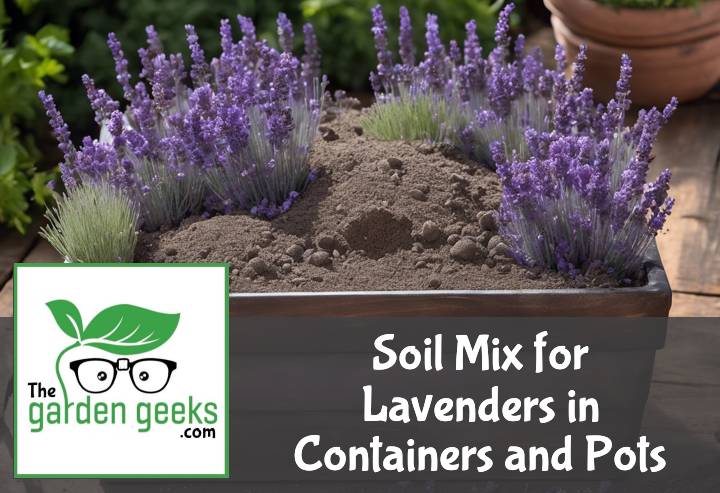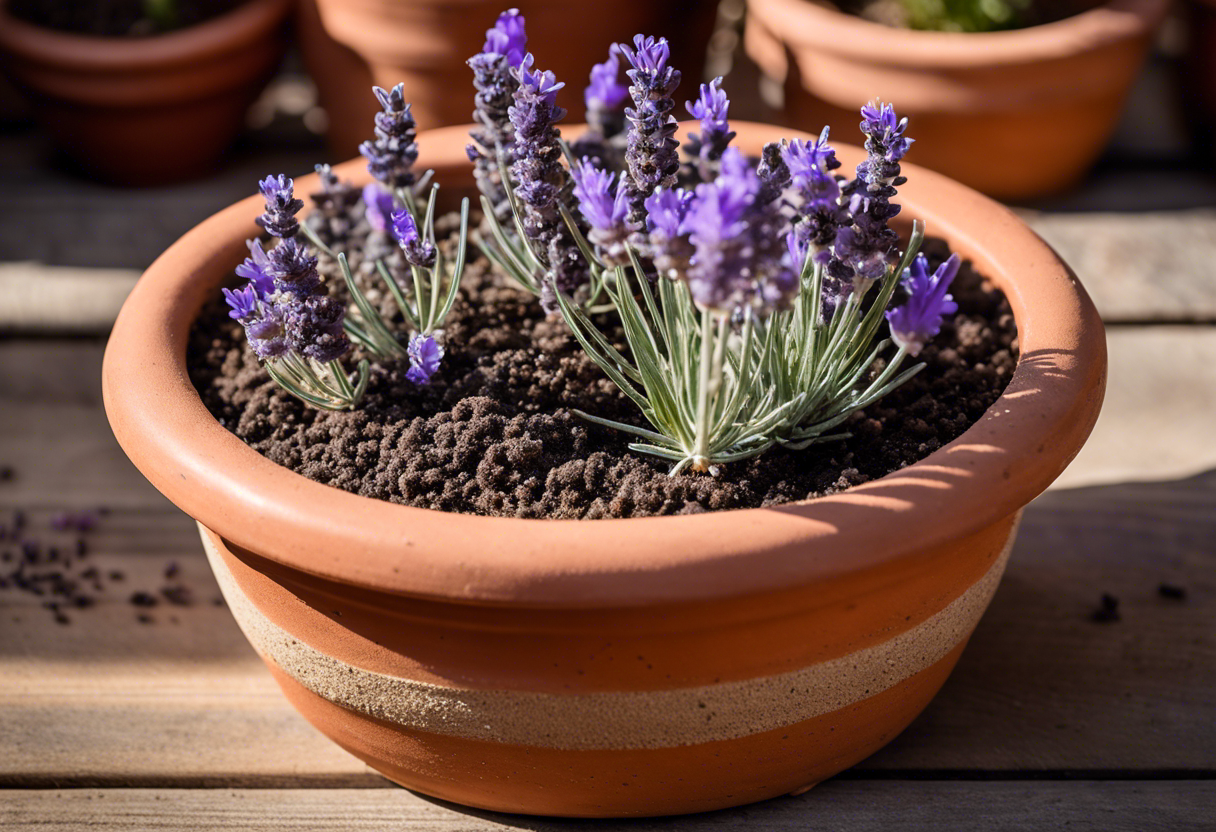Ever wondered why your lavenders aren’t thriving as much as they should in their pots or containers? Well, I’m here to tell you that it might just be due to the soil mix you’re using. Yep, you heard me right! The Soil Mix for Lavenders in Containers and Pots can make a world of difference in how your lovely lavenders grow.
In my own gardening escapades, I’ve learned that getting the soil mix right is half the battle won. So buckle up, fellow plant enthusiasts! We’re about to embark on a journey to discover the perfect soil mix recipe for container-grown lavenders. Keep reading about Soil Mix for Lavenders in Containers and Pots.
Key Takeaways
- Lavenders thrive in well-draining soil that mimics their native Mediterranean habitat.
- A good mix for lavenders in containers and pots is 1/3 garden soil, 1/3 compost or well-rotted manure, and 1/3 sharp sand or grit.
- Adjust the mixture depending on your local climate; more sand for wet climates, more compost for dry ones.
- Regularly check the pH level of the soil; lavenders prefer slightly alkaline conditions (pH 6.5 to 7.5).
- Over-watering can cause root rot, so ensure proper drainage.
Why is Soil Mix Important for Lavenders in Containers and Pots?
When it comes to lavender plant care, the importance of soil mix can’t be overstated. Especially when we’re talking about container gardening. The right potting soil for lavenders can make all the difference in their growth and blooming.
Understanding the Nature of Lavender Plants
Lavenders are a unique bunch, with certain characteristics that set them apart. For starters, they’re native to the Mediterranean region. This means they’re used to well-drained, sandy soils and lots of sun. When you’re growing lavender in pots, these traits need to be considered.
They also have specific needs that differ from other plants. For instance, they don’t like having wet feet – too much water can lead to root rot. So, if you want your container-grown lavender to thrive, you’ll need a soil mix that mimics its natural habitat.
The Role of Soil in Lavender Growth
Soil plays a big role in any plant’s life, but it’s especially important for lavenders. It provides essential nutrients needed for growth and flowering. But not just any soil will do – lavenders prefer a leaner soil with lower fertility.
The other crucial aspect is water drainage. Remember how I said lavenders don’t like wet feet? Well-drained soil ensures excess water doesn’t stick around longer than welcome. This helps prevent issues like root rot and keeps your lavender happy and healthy.
Specific Needs of Container-Grown Lavenders
Container-grown lavenders have different needs compared to those grown in gardens or fields. In containers, there’s less space for roots to spread out and less soil to hold onto moisture.
This means potted lavenders need a special kind of care – including the right soil mix! A good rule of thumb is using a blend of coarse sand, peat moss, and perlite. This mix ensures good drainage while still providing the necessary nutrients.
Remember, a happy lavender is one that’s well cared for – and that starts with the right soil mix for lavenders in containers and pots!
What Constitutes an Ideal Soil Mix for Lavenders in Containers and Pots?
When it comes to creating the perfect lavender soil mix, there are a few key elements to consider. It’s not just about shoveling some dirt into a pot and sticking a plant in it, no siree!
Importance of Drainage and Aeration
First off, let’s talk about drainage and aeration. These two factors are like the lifeblood of your potted lavenders. Without proper drainage in container gardening, your lavender’s roots can become waterlogged, leading to root rot. Not exactly the lush, fragrant lavender you were hoping for, right?
But wait, there’s more! Aeration is equally important. Good aeration for potted plants ensures that your lavender’s roots have access to vital oxygen. This helps promote healthy root health in lavenders and encourages overall plant growth.
Nutrient Requirements for Healthy Lavender Growth
Next up on our list of must-haves for an ideal soil mix for lavenders is nutrients. Just like us humans, plants need food too! And lavenders have their own specific dietary needs.
Lavenders thrive best with certain nutrients for lavender growth, such as nitrogen, phosphorus, and potassium. These essential nutrients contribute to robust growth and help keep your lavender looking its best.
Balancing pH Levels for Optimal Growth
Last but certainly not least on our checklist is pH balance. The pH level of your soil can make or break your lavender’s health.
Lavenders prefer slightly alkaline soil conditions. So keeping an eye on the soil pH for lavenders is crucial if you want them to thrive. Striking that perfect balance in pH levels can lead to optimal growth and a happy, healthy lavender plant.
How to Prepare the Perfect Soil Mix for Your Lavenders?
Getting your soil mix for lavenders in containers and pots just right is a big deal. It’s like cooking up a gourmet meal for your plants! You see, lavenders are a bit picky about their living conditions. They need just the right balance of nutrients, pH levels, and soil structure to thrive.
Choosing the Right Base Soil
When it comes to lavender base soil selection, think light and airy. Lavenders love well-drained soils that don’t hold on to water too long. A good starting point? Try a mix of coarse sand and lightweight potting mix.
But wait, there’s more! The best soil for lavenders also needs to be rich in organic matter. So, consider adding some compost or aged manure into the mix. This will provide your lavender with essential nutrients while keeping the soil structure loose and well-aerated.
Adding Necessary Amendments
Now let’s talk about lavender soil amendments. These are like vitamins for your plants – they help boost health and growth. For lavenders, adding lime can be beneficial as it helps increase the alkalinity of the soil.
Another great amendment? Perlite! This little powerhouse helps improve drainage while also promoting root growth. And let’s not forget bone meal – it’s packed with phosphorus which is key for strong root development in lavenders.
Adjusting pH Levels
Finally, we come to adjusting pH for lavenders. Lavenders prefer slightly alkaline soils with a pH between 6.7 and 7.3. To achieve this sweet spot, you may need to add some garden lime or wood ash.
Remember though, always test your soil before making any major changes! Too much of a good thing can quickly turn bad if you’re not careful with your adjustments.
So there you have it, folks! A crash course in lavender soil preparation. With the right base soil, necessary amendments, and pH adjustments, you’ll be well on your way to creating the perfect lavender potting mix. Happy gardening!
Common Mistakes to Avoid When Preparing a Soil Mix for Lavenders in Containers and Pots
Oh boy, we’ve all been there! You’re super excited about your new lavender plants, but then you make some rookie mistakes. Let’s talk about the common lavender soil preparation mistakes like over-fertilizing, ignoring pH levels, and neglecting drainage and aeration.
Over-Fertilizing the Soil
Here’s the thing: lavenders aren’t big eaters. They don’t need heaps of fertilizer. In fact, over-fertilizing lavenders can harm them more than help. Too much food can lead to weak growth and fewer flowers – not what we want!
Now, how do you know if you’re overdoing it? Well, signs of over-fertilized lavender include yellowing leaves and stunted growth. So remember folks, less is more when it comes to feeding your lavenders!
Ignoring pH Levels
Next up on our list of no-nos: ignoring pH levels. Lavenders love slightly alkaline soil with a pH between 6.7 and 7.3. If you ignore this and let the soil become too acidic or too alkaline, your plants won’t be happy campers.
The effects of wrong pH on lavenders can be pretty grim – think poor growth and fewer blooms. So don’t forget to check that pH level regularly!
Neglecting Drainage and Aeration
Last but not least, let’s chat about drainage and aeration. These are crucial for healthy lavender growth – they love well-drained soil that lets their roots breathe.
If you neglect these aspects (we’re looking at you, soggy pots), you’ll end up with root rot or fungal diseases – yikes! So make sure your soil mix for lavenders in containers and pots has good drainage and aeration. Your plants will thank you for it!
Tips to Maintain the Quality of Your Soil Mix Over Time
Maintaining the quality of your soil mix for Lavenders in Containers and Pots is essential. It’s all about regular pH checks, nutrient replenishment, and ensuring proper drainage.
Regularly Checking and Adjusting pH Levels
Lavender plants are quite picky when it comes to soil acidity. They prefer a slightly alkaline environment with an ideal pH between 6.7 and 7.3. So, soil pH testing is crucial.
To maintain this level, you may need to adjust the soil pH occasionally. This involves adding lime or sulfur-based amendments based on whether your soil is too acidic or alkaline respectively.
Replenishing Nutrients as Needed
Lavender plants need a balanced diet too! If they start looking a bit peaky, it might be due to nutrient deficiency. Essential nutrients like nitrogen, phosphorus, and potassium are key for healthy growth.
Replenishing these nutrients can be done by adding a slow-release fertilizer into your nutrient-rich soil mix for lavenders. Remember not to overdo it though – lavenders don’t like overly rich soils!
Ensuring Proper Drainage
Finally, let’s talk about water – or rather how to get rid of excess! Lavenders hate having wet feet and poor drainage can lead to root rot.
To prevent this disaster, make sure your pots have adequate drainage holes at the bottom. You could also add some grit or sand into your soil mix to improve its drainage capabilities.
And there you have it – maintaining your soil mix for Lavenders in Containers and Pots isn’t rocket science after all!
To Wrap Up
In the end, it’s all about creating the perfect “soil cocktail” for your lavender. Like a master bartender mixing a top-notch mojito, you’ve got to get the balance just right. And remember, Soil Mix for Lavenders in Containers and Pots isn’t rocket science – it’s more like baking a cake.
So go on, roll up those sleeves and let your green thumb do its magic. You’ll be inhaling that sweet lavender aroma before you know it!





